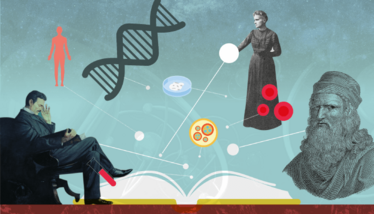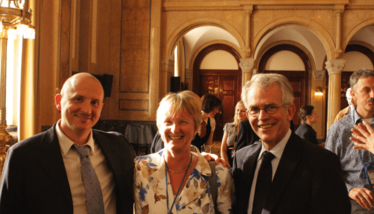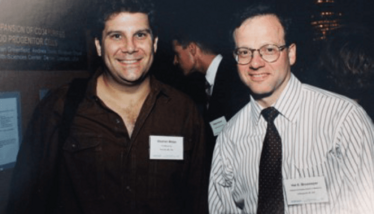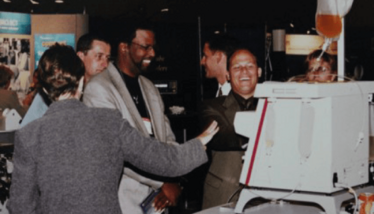
“Curing Cancer? That’s Cute”
From the fringe of the fringe to the brink of a revolution in medicine; this is the cell and gene therapy story as told by the society that was there at the very beginning – the ISCT

In the early 2000s, Catherine Bollard took the stage at an international scientific meeting to tell delegates about her work using T cells to treat cancer – an approach that would eventually be described by an FDA Commissioner as “revolutionary.” But she wasn’t presenting to a packed auditorium. She was in a small room away from the bigger sessions and recalls, “Pretty much everyone there was a friend.”
Cell and gene therapies may be an integral part of today’s treatment triumvirate: small molecules, large molecules, and advanced medicines. But it wasn’t long ago that today’s star researchers were seen as outsiders by the mainstream. “There wasn’t a lot of enthusiasm for cell therapy,” says Bollard, Professor of Pediatrics and Immunology at The George Washington University and Children’s National Hospital and Past-President of the International Society for Cell and Gene Therapy (ISCT). “Colleagues were either impressed that we were working on something so ‘out there’ or, more often than not, skeptical or dismissive. The idea of using the body’s immune system to kill cancer was like voodoo to many oncologists.”
“The scientific community would say, ‘Well, isn’t that cute, but will it ever work?’” says Bruce Levine, Barbara and Edward Netter Professor in Cancer Gene Therapy at the University of Pennsylvania and ISCT President. “That skepticism was always in the back of your mind.”
In the early days of cell therapy, researchers came together – escaping the back rooms of bigger conferences – to share their radical ideas at ISCT meetings. Back then, ISCT was known as ISHAGE (“ice age”): the International Society for Hematotherapy and Graft Engineering. “There were researchers looking at stem cell transplants, graft engineering, T cell depletion, and things like that,” says Levine, who joined in 1999, just after he and Carl June re-established their cell manufacturing facility at the University of Pennsylvania. “We saw the society as an important resource because there was no roadmap for cell therapy – you had to chart your own path.”
“They were quite small, boutique meetings back then,” says Bollard. “And they were more focused on stem cell processing, so we in cancer immunotherapy were actually on the fringes – the fringe of the fringe!”
“They were small in comparison with today’s meetings,” adds Levine. “But they were and remain a great source of support, education, and monitoring. Perhaps most importantly, in those early days, they were eye-opening for attendees. They realized they weren’t alone in their institutions – there were people on all six continents working alongside them in the field.”
Miguel Forte, Chief Executive Officer at Bone Therapeutics and ISCT Immediate Past Chief Commercialization Officer, remembers being “flabbergasted” at the cultural difference between the ISCT meetings and the big oncology and rheumatology meetings. “When I first attended 10 years ago, it felt like a handful of people with different starting technologies ranging from reconstructing a lung to using mesenchymal stem cells (MSCs) to treat autoimmune diseases,” he says. “As Bruce said, it was seen as a ‘cute’ thing – like we were just playing with technology. But look where we are only a decade later…”

ISCT 2011 Rotterdam Co-Chairs (L to R): Massimo Dominici, Ineke Slaper-Cortenbach, Fred Falkenburg.
Credit: ISCT Photo Archives
Good science, good mentors – and passion
At its core, the cell and gene therapy story is about innovation. For any innovation to succeed, you need something simple, yet crucial – belief. So what was it that made the early pioneers in advanced medicine believe that they, despite skepticism from colleagues, would bring about a revolution in medicine?
For Bollard, it came down to three things: mentorship, confidence, and passion. “This year’s ISCT annual meeting is a special one because I had the chance to present the Lifetime Achievement Award to my mentor and former boss, Malcolm K. Brenner,” she says. “If it weren’t for Malcolm being President of ISCT, I probably wouldn’t have joined ISCT in the early 2000s. His support was invaluable early in my career – and now I’m presenting his award as past-president. It feels like I’ve come full circle.”
Science was also of paramount importance. Bollard says that she was convinced of the merit of focusing on the immune system – and “wasn’t willing to take no for an answer.” The experience of watching a friend suffering from Hodgkin’s lymphoma go through multiple, ultimately unsuccessful, rounds of chemotherapy and radiotherapy solidified her belief that there had to be another way – and fueled her passion for finding it.
“The treatment was initially successful and she went into durable remission. She then got married, immigrated to America, and was getting on with her life before being struck with acute leukemia. She died within six months of her diagnosis,” says Bollard. “That leukemia was the direct result of the previous bouts of chemo and radiation she had received, and I just thought, ‘There has to be a way to kill cancer without killing healthy cells.’ Even then, researchers knew that the immune system was our best natural defense against cancer.” With that, Bollard’s path was set. “When you’ve got strong beliefs in the science, fantastic mentors, passion, and drive, you’re going to be resilient and find new angles when you face challenges – even when people tell you that what you’re doing is crazy.”
Levine says one of the most impactful books he read early in his career was Commotion in the Blood (1997), which laid out the roller coaster history of the first 100 years of immunotherapy. “Throughout the book you can relive the disappointments of early investigators and the skepticism and scorn of the wider scientific community,” he says. “I read this just after Carl June had asked me to start a cell manufacturing laboratory to support an adoptive immunotherapy trial, and we were collaborating with Cell Genesys on the very first Chimeric Antigen Receptor clinical trials. Now Carl is the ultimate optimist and mentor. But, if the rest of science is putting you down, who is right? Well, into my career comes ISHAGE/ISCT, and I thought that if Carl’s crazy and I am crazy, we might as well be crazy together trying to get this technology to work.”
For Levine, it was meeting patients that most kept him motivated in the face of skepticism. “I will never forget going in to meet a patient on one of our myeloma trials to thank her for enrolling,” he says. “She kindly looked at me and said, ‘Why would I not volunteer?’ These patients placed their faith and hope in us and that was a great responsibility to them and to their families. Mix in the great team when we moved to the University of Pennsylvania and the support from colleagues and friends in ISCT and you have all the motivation needed.”

ISCT members enjoying the poster hall. 90’s era ISCT exhibit hall Credit: ISCT Photo Archives
Completing the revolution
As the years went by, cell therapy’s clinical results spoke for themselves. Early skepticism regarding therapeutic efficacy gave way to concerns about logistics and commercialization. All the while, the number of people entering the field increased substantially across various disciplines. “Traditionally, only bone marrow transplant doctors administered cell therapies,” says Bollard. “Now, the field is open to oncologists, cardiologists, orthopedists, and many more disciplines – and this is reflected in the growth of ISCT membership and its annual meeting.”
Fast-forward through years of scientific advancements, hurdles, and setbacks to 2017, when Novartis pulled off the impossible: the first CAR T cell therapy approval – a huge moment for the field. But, according to Forte, economics was key: “Here, we had Novartis come in and say, ‘We’re going to do this at a large scale and spend a lot of money taking the products through clinical trials – and be successful with the approval.’ It proved to other big pharma and biotech companies that the business model was viable. It was game-changing.”
So far, where CAR T has been adopted, healthcare systems have coped well with the logistical challenges. Payers, too, have been generally willing to consider new pricing and reimbursement models to support curative (though often expensive) treatments. But, as the afterglow of the first approvals begins to wear off, the cell and gene therapy field is coming to terms with the fact that it hasn’t revolutionized medicine – yet. For that to happen, it will have to crack solid tumors – and to deliver at scale it will likely go down the allogeneic (off-the-shelf) route.
“We’re beginning to see success with allogeneic “off the shelf” approaches, which is great, but the next step for the field is for cell and gene therapy approvals to become more “mainstream”– that will really put advanced cell therapies on par with the more traditional approaches,” says Bollard. “But the real blue-sky potential is finding a cell therapy to routinely cure solid tumors. An approved therapy there could be groundbreaking for the field and, more importantly, for patients. We could potentially treat millions of people worldwide.”
“I’m excited about combination approaches to enhance the efficacy of CARs and the progress that is being made in solid tumors,” says Levine. “As the field evolves, we’re going to see an increase in the integration of diagnostics and biomarkers in determining which cell and gene therapy to give to a patient. We’ve already done some work on predicting responses in CAR T patients.”
Although looking forward to allogeneic cell therapy’s evolution in the coming years, Forte mainly wants to see the field optimize existing approaches. “Now that we know the cell works – and that it can be made into a commercial product – we need to optimize everything,” he says. “That means modulating cell function to make treatments more effective or off-the-shelf, improving how we source cells – induced pluripotent stem cells (iPSCs) will become increasingly important here – and how we deliver them.”

ISCT members enjoying the poster hall. 90’s era ISCT exhibit hall Credit: ISCT Photo Archives
Holding it all together
Forte says the growth of the society has mirrored the growth of the industry. “For example, ISCT’s commercialization committee was established to keep track of the challenges facing developers trying to turn these therapies into commercial realities,” he says. “There are many such challenges – but they’re good problems to have.” And over the years, the organization has further broadened its scope to include committees on legal and regulatory affairs and quality/operations, as well as other stakeholder committees, such as the Presidential Task Force (PTF) on the Use of Unproven and/or Unethical Cell & Gene Therapies, and Early Stage Professionals Committee.
In recent months, the field has joined countless others in facing the difficulties raised by the COVID-19 pandemic. In many countries, hospitals simply weren’t permitted by governments to conduct non-COVID-19 related trials. Elsewhere, patients have been more reluctant to travel to hospitals because of the risk of infection, which has affected trial recruitment. “Bone Therapeutics had two studies approved at the beginning of the pandemic; we had to halt recruitment and wait for the situation to improve,” says Forte. “We saw that things were improving in Hong Kong, which is where we recruited our first patients, but we have now (at the time of writing in July) started to recruit patients in Europe too.”
Investor attitudes have also shifted as the scale of the pandemic unfolded. “Investment by no means dried up, but the discussions did change with the onset of the pandemic,” Forte says.
Unscrupulous “clinics” preying on pandemic fear also popped up. And so, ISCT members have intensified their efforts against unproven cell and gene therapies for COVID-19 and led calls for proper clinical procedures for legitimate COVID-19 therapies. The pandemic also affected ISCT’s annual meeting, which was due to take place at the end of May in Paris. ISCT decided to go virtual; our “How to Deliver a Virtual Conference in Under Two Months” sidebar reveals how they did it – and how it went.
But, at the time of writing, economies are beginning to open back up, paving the way for advanced medicine development to resume. So, as the field continues to evolve, what will ISCT look like in the next 10 to 20 years?
Forte believes ISCT may have to play a greater role in the ethical debates that will take place as the field reaches its full potential. “The sky’s the limit when it comes to what you can do with cells in terms of reconstructing, modulating, and improving function,” he says. “The benefits for patients will be tremendous, but we’re not too far away from being able to go beyond restoring health to designing specific traits.” Cell and gene therapies could be used to change how we look, how we think, and even how long we live – raising a wide range of ethical questions. “We might be entering the realms of science fiction here, but CAR T cell therapy sounded like science fiction just 10 years ago,” says Forte. “ISCT is well placed to be part of these discussions and to take a position on them – we have to make sure there’s an ethical dimension to everything we do.”
Another interesting development is the rise of China as a hotspot of advanced therapy development. “China’s importance to the global cell and gene therapy industry is set to increase and that has important implications – especially as their regulations continue to evolve – for companies in Europe and the US,” says Levine. “Many discussions are taking place between Western and Chinese companies about potential partnerships. But challenges such as IP protection, movement of goods and people, and cultural differences must be overcome. ISCT is a global organization with recognition in China, but I think there is scope to increase our presence there and to engage Chinese players further to help facilitate collaboration.”
For Levine, as President of ISCT, the big challenge is having a global perspective and vision while also respecting local needs. “We need a global exchange of ideas and information, but cell therapy must also respect patients and physicians at the local level,” he says. “We recognize that not every country has the infrastructure or the expertise to review and regulate the conduct of translational and clinical research in cell and gene therapies. This is exactly where ISCT can serve as a resource and forum to connect researchers, clinicians, and regulators.”
For Bollard, it is amusing to discuss how we can bring together the global cell and gene therapy industry, given how different things were only a decade ago. “You could have never predicted back then, ostracized as we were, that we would be embraced by the scientific community and industry and talking about how to get proven technologies to millions of patients,” she says. “The whole thing just takes you by surprise. But the craziest part? The field is still in its infancy and we can still take it so much further.”

Over the course of my Biomedical Sciences degree it dawned on me that my goal of becoming a scientist didn’t quite mesh with my lack of affinity for lab work. Thinking on my decision to pursue biology rather than English at age 15 – despite an aptitude for the latter – I realized that science writing was a way to combine what I loved with what I was good at.
From there I set out to gather as much freelancing experience as I could, spending 2 years developing scientific content for International Innovation, before completing an MSc in Science Communication. After gaining invaluable experience in supporting the communications efforts of CERN and IN-PART, I joined Texere – where I am focused on producing consistently engaging, cutting-edge and innovative content for our specialist audiences around the world.



















